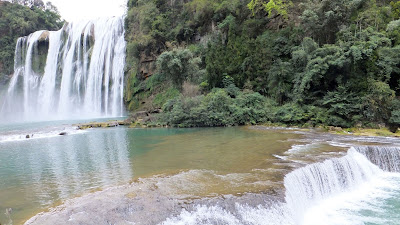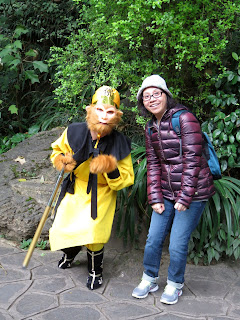
The 100 sq meters scenic area of Huangguoshu Waterfall National Park (黄果树瀑布景区) that are famous for its densely distributed falls cluster with a grand fall as a core, is located about 140km away from Guiyang, the capital city of central south province of Guizhou in China. There are altogether 18 cascades scattering below or above the main fall, each with its own feature. The Main Fall measured as 74 meters with width of 80 meters, is nestled in a lush greenery with a naturally perforated water cave behind it. It is not grand in scale if compared to Niagara Falls of USA and Canada, or even with the Waterfalls of Hukou (壶口瀑布)and Detian (德天瀑布)in China, but it is one of the most peculiar falls in China and East Asia.



Huangguoshu Waterfall from distance, looks like a small milky way dropping down from the heaven. Its water that rushes down from a vertical cliff and falls into the pond at the foot is from the upstream of Baishu-he (白水河).


The main vantage platform is always packed with crowds as it is the best spot to look up and watch the surging water of Main fall, dropping from the bluff into the pond.





The pond where water of Grand fall falling into is named as Rhinoceros Pond (犀牛潭) as it was said that a rhinoceros used to take bath in it in the past, but more people said that it was so called as its shape is like a rhinoceros.


Huangguoshu Waterfall though is not as magnificent and grand as what we expected, it is still the star attraction in China particularly in its homeland, Guizhou Province.


Huangguoshu situated in natural Karst topography, are typical kind of waterfalls formed by the erosion happened within 100-500 thousand of years. The water from the upstream of Baishui River seeped into the slitting gaps underground and when the cracks gradually became larger and larger, more and more water were running into it. As a result, underground rivers and caves were formed causing the whole river valley dried up and eroded. The 17 meters deep Rhinoceros Pond is one of the eroded pit.



Huangguoshu began to have fame in Ming Dynasty after the visit of the reputable traveler and geographer Xu-Xiake (徐霞客) in April, 1636. It was named as Baishui-he Waterfall at that time. The present name of Huangguoshu which literally means Yellow Fruit Tree was later commonly used as there are many yellow Banyan trees around the site and its name (黄葛榕树) sound in Chinese like Huangguoshu. There are actually no trees bearing yellow fruits here.



The rock terraces in Rhinoceros Pond at the base of waterfall are like old relief under water.



The fall of Huangguoshu differs very much on season and weather. It looks vigorous during summers and rainy seasons. We did not have chance to witness its thundering roars as we came in December which is considered as a dry season in Guizhou though it was raining every day.





Huangguoshu escalator is number one lifting height project successfully completed lately in China. It is rather long and steep. For those who cannot walk or who want to save time, it would be a good experience to have a ride which is chargeable at ¥50 (up and down), though exploring Huangguoshu National Park by foot is not really too tough and it takes only about 3 hours.


The station where you arrive and board for the escalator ride is short distance away from the main view point of the Grand Fall.



The suspension bridge across the river offers fabulous sights of water clusters in the park.




Water from Rhinoceros Pond freely meanders downstream.


The flow of River Baishui-he running across the small cascades, ignoring all its admirers, continuously twisted its way towards its own destination.



The beauty of Huangguoshu Waterfalls National Park comes partly from these small cascades which might not be created in the same causes but sharing the same topography. They appear in multiple shapes with various sizes and patterns.












Remains of the three erosion pits, Bunds of Sandao-tan (三道滩), Mati-tan (马蹄滩)and Maoshui-tan (冒水滩) are still visible at the downstream.








When looking down from a higher view point, Rhinoceros Pond looks foamy like covering with sprinkling beads when the water hitting over it.


We were now at a higher view point, opposite the main vantage stage, where we could be further closer to the Grand Falls .









The 134 meters long natural Water Curtain Cave (水帘洞) is just behind the Grand Fall. It is 20 meters deep with channels, windows and halls cutting across the two sides of rocking walls at the back of the Fall. It allows you to closely watch, touch the water and hear the thundering roar of the Fall. We regret to listen to the local guide's advice and did not made the effort to climb up and experienced the thrill.



Have fun with Monkey God!






The entrance fee of Huangguoshu Waterfalls National Park is ¥180+¥50 of inner transportation.



No comments:
Post a Comment